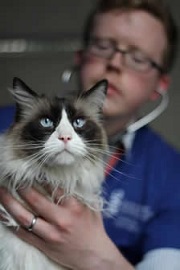Ragdoll Cats
Hypertrophic cardiomyopathy (HCM) is the most common heart disease in cats and an important cause of morbidity and mortality.

The disease causes thickening of the wall of the important pumping chamber, the left ventricle (LV) which results in the build-up of pressure in the heart leading to heart failure, rhythm disturbance and often sudden death. Very little is known about the biochemical and cellular processes which lead to the thickening of the LV and early death. A better understanding would enable us to target treatment towards preventing LV thickening before the cat shows clinical signs.
One such process is the development of fibrous tissue within the wall of the heart before the thickening of the muscle occurs which has been identified in human patient genetically predisposed to HCM.
The RVC research team investigating fibrous tissue metabolism in genetically predisposed ragdoll cats and compare this with LV wall thickness. This can indicate whether an altered fibrotic state exists in heart before the wall becomes very thick. Knowing this may enable us to develop anti-fibrotic therapies to help prevent the wall becoming thickened and thereby prevent clinical signs developing.
To find out more about the research, click here.
